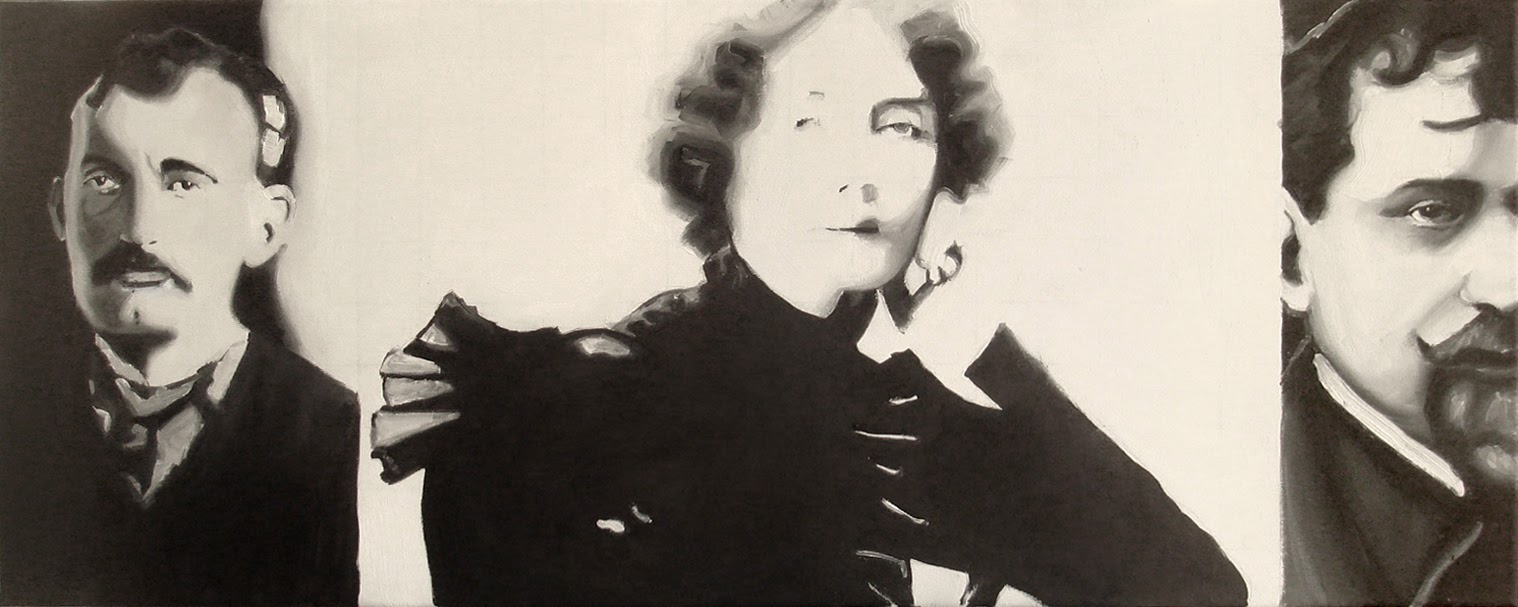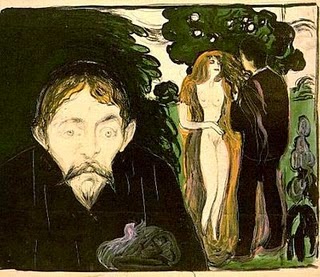 |
| The Krasnals. Whielki Krasnal "Jealousy / Dagny Juel, Edvard Munch, Stanisław Przybyszewski". 2014. Olej na płótnie. 40 x 100 cm |
| Edvard Munch "Jealousy". 1907. 75x98 cm |
 |
| Jealousy, 1896 Lithograph 46.5 x 56.5 cm |
The gloomy-looking figure gazing out of this scene is Munch's friend, the Polish writer Stanislaw Przybyszewski. Munch had an affair with his friend's wife, which is what the imagery refers to. The lithograph relates to a similar painting by Munch of 1895, in which the nude female figure picks an apple from the tree behind her - a reference to the temptation of Adam by Eve. Munch was simultaneously attracted to, fearful of, and puzzled by women. These conflicting feelings are presented in his art: desire is tinged with pessimism, anxiety and melancholy.
http://gundersencollection.com/index.php/gundersen-collection-munch-articles/17-munch-jealousy-2
A large number of sketches and drafts resulted in the painting we now know as Jealousy. It was painted in Berlin in 1895, during the time when he was among the intellectual clique of the city that used to frequent the wine bar Zum schwarzen Ferkel. The female centre of attraction of this circle was the modern, emancipated Dagny Juell, who had come to the city in 1893 to study music. After just a few months, she married one of Munch’s friends and the leading figure of the circle, the German-Polish writer Stanislaw Przybyszewski. Many of the men in the group felt attracted by her – including Munch himself and August Strindberg.
The domestic triangles that were in the offing may have inspired Munch to use the motif. The person portrayed displays likenesses with Przybyszewski, who is shown here en face and pushed right forward in the picture surface. The face with the staring eyes is surrounded by a dark surface. Munch wrote about the motif: “A mysterious gaze, that of the jealous man – in these two gimlet eyes, as in a crystal, many reflected images are concentrated – The gaze is enquiring, interested, hateful and full of love – the quintessence of the woman all of them have in common.”ii The basis for his jealousy and dark thoughts, as enacted in his mind, is made clear in the right-hand section of the picture. A lightly clad woman is openly flirting with a male figure – Dagny and Munch?
Both Strindberg and Przybyszewski mentioned Munch’s picture, and the latter dealt with the theme in his own literary works, such as The Vigil (1893) and Overboard (1896). When Munch exhibited the picture in Paris in 1896, Strindberg wrote the following: “Jealousy, the sacred awareness that one’s soul is one’s own, that it abhors being mingled with another man by woman’s agency. Jealousy, a legitimate egoism, born of the instinct to preserve the self and the race. The jealous man says to his rival: ‘Away with you, worthless fellow; you will warm yourself at fires I have kindled; you will inhale my breath from her lips; you will suck my blood and remain my slave, for you will be ruled by my spirit through this woman, who has become your master.’”
http://tomojkawalekpodlogi.blogspot.com/2013_06_01_archive.html
Dagny, norweska piękność, która rozpalała wszystkich napotkanych mężczyzn, nawet homoseksualistów. Rudowłosa, inteligentna, błyskotliwa, mieszanka świętej i ladacznicy, wiejskiej panienki i femme fatale, potrafiła być namiętną kochanką, równym partnerem w dyskusji intelektualnej, kumplem, przyjacielem, żoną i matką. Samodzielna i niezależna, decydowała o swoim życiu w czasach, gdy kobietom odmawiano do tego prawa.

No comments:
Post a Comment